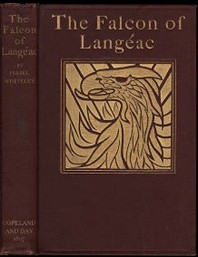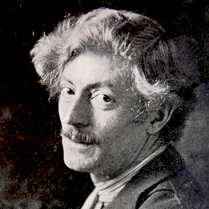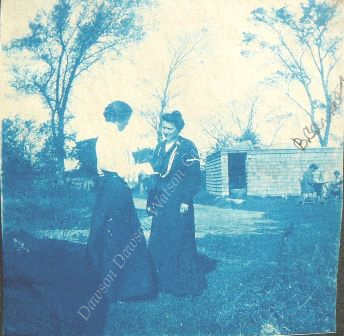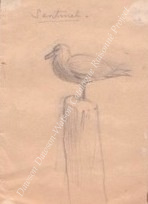- 1893 – While in Giverny, the painter James Carroll Beckwith (1852–1917) convinced Dawson-Watson to move to America. In May 1893, the Dawson-Watsons left Liverpool, England, and set sail for New York City on the SS Servia, Cunard Line, arriving on June 1st. Dawson-Watson was 28 years old. From New York, the artist and his wife sailed to Boston to visit Lilla Cabot Perry and her family. They subsequently spent the summer in the Ponkapoag (Massachusetts) home of Perry’s brother, Dr. Arthur Tracy Cabot.
In October of 1893, the Dawson-Watsons moved to Hartford where the artist had accepted a position as Art Director and Instructor at the Hartford Art Society. During his four years at the school, Dawson-Watson strengthened his students’ technical abilities while encouraging their artistic independence. According to the Society’s minutes:
Mr. Dawson-Watson, whether one fully agrees with his manner of painting or not, is a most successful teacher, well instructed in the best schools of England and France, and having a thorough knowledge of technique, he believes in making his pupils work out their own manner and methods. He aims to develop each pupil’s individuality, instead of making copyists. At the same time, he is very particular as to accuracy in drawing, and is himself a forcible draughtsman. The improvement of the pupils under him has been very marked, and the work done compares favorably with that of other schools. (as quoted in Elizabeth J. Normen, “Art School Forged in the Gilded Age: The Hartford Art School,” Connecticut Explored 1, [Summer 2003], ctexplored.org/an-art-school-forged-in-the-gilded-age-the-hartford-art-school, accessed October 7, 2014).
It was in Hartford that Dawson-Watson’s two children were born, a son, Edward Dawson (born November 1, 1893) and a daughter Hilda Rosalind (born February 3, 1895).
While residing in Hartford, the Dawson-Watsons spent their summers in Scituate, Massachusetts; South Manchester, Connecticut; and Farmington, Connecticut.
- 1894 – In January, Dawson-Watson exhibited at the St. Botolph Club in Boston with fellow impressionists Frank Weston Benson, Joseph DeCamp, Phillip Leslie Hale, Lilla Cabot Perry and Edmund C. Tarbell.
Photograph of the Scituate coastline.
(Dawson Dawson-Watson family archives)
Dawson-Watson, Scituate Cliffs, ca. 1897, watercolor on paper, 5 x 7 in.
(Dawson Dawson-Watson family archives)
It was during these years that Dawson-Watson was painting rural scenery with the loose brushwork and heightened palette of Impressionism. One particular example of his work during this time period is Early Morning on the Farmington. In a National Endowment for the Arts (NEA) publication the article, “Connecticut Millenium Trail Celebrates American Impressionism”, depicts the scenic Farmington River that inspired Dawson-Watson to paint this scene.
Dawson-Watson completed a series of designs for the Cheney Silk Mills located in South Manchester, Connecticut. It is likely that these designs were made during his summers there.
Dawson-Watson, Design for Silk (wallpaper), 1896, Watercolor on board, 18 x 11 1/2 in. (Dawson Dawson-Watson family archives)
- 1896 – Pope Manufacturing Company, Boston: Columbia Bicycle Competition
In about 1896, Dawson-Watson had an idea that the Pope Manufacturing Company, which made the Columbia bicycle, could use a poster for their advertising. As an acquaintance of Colonel Albert Augustus Pope, the head of the company, Dawson-Watson created a large poster and presented it to him. At the time, Pope was not interested in the project. However, a few months later, he decided to hold the first poster competition in the United States.
The contest prizes were $250, $200 and $150. Dawson-Watson submitted five entries approximately 24 x 36” in size. There were 600 entries, with Maxfield Parrish receiving first prize. With the consent of the contestants, each and every entry was mounted on cloth and a light stretcher. The whole collection was shipped from Boston to towns all over the United States for a period of one year. The press coverage of the competition included an article appearing in the New York Times on March 16, 1896.
- ca. 1896 – While in Hartford, Dawson-Watson became friends with the American landscape painter Allen Butler Talcott (1867–1908). The two men painted and sketched together frequently, were absolutely congenial, and Dawson-Watson thought the world of him. The two artists had a joint exhibition at the Wadsworth Atheneum.
During this time, Dawson-Watson received notice of a $3,000 inheritance from his aunt. He decided that this was an opportunity for him to return to Wales and resigned his position at the Hartford Art Society. While waiting for his bequest, the Dawson-Watsons lived in Scituate for a year.
- 1897 – Dawson-Watson completed a front cover engraving in gilt for the first edition of Isabel Whitley’s The Falcon of Langéac (Boston: Copeland and Day, 1897).

The Falcon of Langéac
Study for the cover of The Falcon of Langéac by Dawson-Watson (Dawson Dawson-Watson family archives)
Courrier Innocent
- no. vii edition (Spring 1897) (click image for slide show) (Dawson Dawson-Watson family archives)
- The Engraver
- The Engraver
- For France
- For France
- For France
- For France
In the winter of 1897, while living in Scituate, Dawson-Watson had the idea to create the next edition (the sixth), of the Courrier Innocent. Contributors to this Winter edition were the painters Theodore Earl Butler, Thomas Meteyard, the poets Bliss Carman and Richard Hovey, the architect Ralph Adams Cram and Dawson-Watson.
The final edition of the Courrier Innocent (the seventh), published in the spring of 1897, featured the same contributors as the previous number. “The Engraver” and “For France” are two poems in this issue.
For these two issues, a more labor intensive printing process was adopted. Woodblocks were carved with pen knives and then printed on paper using a rolling pin and a piece of felt. Dawson-Watson described the technique in his article, “The Rolling-Pin in Art,” published in the Literary Review in May 1897.
Dawson-Watson was editor, subscription solicitor and sales agent for the Courrier Innocent. It had a list of sixty subscribers. Reviewers from all over the country asked for copies, but Dawson-Watson wrote in his memoir that they were just too much work and too precious to be given away. Copies were sold at the Old Corner Bookstore, which today is the oldest commercial building in Boston, built in 1718.
Photograph of the painter Thomas Meteyard (standing), the Canadian poet Bliss Carman (far right) and friends at Meteyard’s home, Testudo.
(Dawson Dawson-Watson family archives)
Photograph of Testudo, the home of Thomas Meteyard, with Bliss Carman and Dawson-Watson pictured on the right.
(Dawson Dawson-Watson family archives)
- ca. early 1898-1901 – Upon receiving his inheritance, Dawson-Watson and his family left Boston for Wales. After spending several years there, they then moved on to England. According to his memoir, these four years were a bitter struggle. We do know that during this period he received a commission to paint two pyramidal panels 25 x 10 feet at the point of the pyramid (unlocated).
Dawson Dawson-Watson, Sentinel, pencil on paper, 4 1/8 x 2 5/8 in. (10.48 x 6.67 cm) (Dawson Dawson-Watson family archives)
New York, Passenger Lists, 1820-1957, Ancestry.com (online database), accessed October 7, 2014.
Elizabeth J. Normen, “An Art School Forged in the Gilded Age: The Hartford Art School,” Connecticut Explored 1 (Summer 2003)
Leadership Initiatives /National Millennium Projects; National Endowment for the Arts and the Humanities; A Clinton Administration Project, 1998-2000.
Dawson Dawson-Watson. The Falcon of Langeac. 1897. Martha Blakeney Hodges Special Collections and University Archives, UNCG University Libraries. http://libcdm1.uncg.edu/cdm/singleitem/collection/tb1/id/1240/rec/1, (accessed September 21, 2015).
Bliss Carman, The Pall Mall Magazine, date unknown.
Dawson Dawson-Watson, “Things Remembered,” manuscript memoir, Dawson-Watson family archives.









